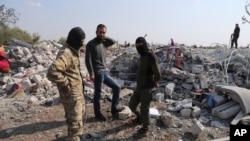The United States is promising there will be no easing of its offensive against the Islamic State after the death of the group’s leader.
U.S. officials say Abu Bakr al-Baghdadi was killed as part of a “dangerous” nighttime raid in northern Syria.
Baghdadi took command of the group formerly known as al-Qaida in Iraq in 2010. The Islamic State (IS) is also known as the Islamic State of Iraq and Syria, or ISIS.
President Donald Trump announced on Sunday that Baghdadi died “whimpering and crying” in a dead-end tunnel. His death shows America’s “commitment to the…defeat of ISIS and other terrorist organizations," the president said.
"We know the successors,” he added. "And we already have them in our sights."
Efforts to find them may be helped by the raid on Baghdadi’s camp in the Syrian province of Idlib. The raid led to the capture of a small number of Islamic State group officials and fighters.
Trump said U.S. forces found "highly sensitive material and information... much having to do with ISIS, origins, future plans, things that we very much want."
That information may have led to the death of Abu Hassan al-Muhajir, a spokesman for the group. The commander of the U.S.-supported Syrian Democratic Forces reported Sunday that he was targeted and killed in an operation in northern Syria.
U.S. officials have yet to confirm reports of his death.
Islamic State: an adaptive, potent terror group
Military and intelligence officials admit that finding and killing IS operatives has not been effective enough to stop the group. It has, however, severely limited its ability to strike at targets.
At one point, in late 2015, officials said airstrikes by the U.S.-led coalition were killing one mid-level or senior-level IS leader every two days.
U.S. anti-terrorism officials later described some of those strikes as “significant blows.”
Yet, IS continues its campaign of terror, even as its self-declared caliphate collapsed. As the Syrian city of Idlib fell to coalition forces, the group’s leadership worked to create an active and growing resistance force.
“ISIS is working (toward) an insurgency in Syria and Iraq” that is made of different groups in both countries, a U.S. official recently told VOA.
“The group is using these (groups) to undermine local governance and reconstruction efforts,” said the official, who added that IS creates ethnic and religious divisions to fuel unrest.
Baghdadi death
Former U.S. Director of National Intelligence James Clapper describes the operation that killed Baghdadi as important because of its symbolic value. But he added that Baghdadi’s death alone will not destroy the terror group.
“ISIS has been more de-centralized and has groomed leaders for just this eventuality,” Clapper told VOA.
Terrorism experts say there is growing evidence that suggests strikes like the one that killed Baghdadi are rarely death blows.
“The death of a jihadist leader is always a dangerous moment for the group as it can lead to internal struggles,” said Michael Horowitz. He is head of intelligence for Le Beck, a Middle East-based security company.
“[Al-Qaida leader Osama] bin Laden was replaced by his former number two, [Ayman] al-Zawahiri,” he said, adding that the al-Qaida leader is still powerful.
Recent intelligence from the U.S. and other countries suggests Islamic State will easily survive without Baghdadi. While the group has lost its caliphate in Syria and Iraq, it still had an estimated 10,000 to 15,000 thousand fighters across those countries. Officials also believe it still has a lot of money, possibly up to $300 million.
And U.S. officials say IS has many of its trained fighters, moving them underground as it lost its Syrian base to U.S.-backed forces.
“The group has tens of thousands of seasoned fighters and hundreds of leaders who have survived decades of war,” said Bill Roggio. He is with the Washington-based Foundation for the Defense of Democracies.
U.S. officials have warned that IS has built itself in such a way that the loss of its caliphate had less effect on the group than many believed.
"The so-called ISIS caliphate has been destroyed, but the ISIS (name) lives on around the world,” State Department Counterterrorism coordinator Nathan Sales said in August.
I'm Susan Shand.
VOA’s Jeff Seldin reported this story. Susan Shand adapted it for VOA Learning English. George Grow was the editor.
Write to us in the Comments Section or on our Facebook page.
________________________________________________________________
Words in This Story
whimper – v. to make a quiet crying sound
tunnel – n. an underground passageway
successor – n. one that follows; replacement
origin – n. root; a rise of beginning
senior – adj. involving a higher level or standing
caliphate – n. the kingdom of a Muslim ruler
reconstruction – n. the act of rebuilding something
groom – v. to educate someone to do a specific thing
jihadist – n. someone who is fighting a religious war
internal – adj. within an organization










